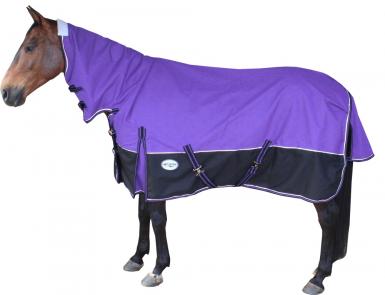Horsezone News
Guide to Rugging for a Shorter Winter Coat
By: Caribu Horse Wear
 |
| Eclipse 1200 Denier Waterproof Rainsheet Combo Horse Rug for $96.95 offers great versatility year round. |
 |
|
1200 Denier 300Gr Lined Turnout Combo Winter Horse Rug for $120.95 will keep your horse dry and warm in cooler weather. |
When should I start rugging my horse to slow the growth of a winter coat? We get asked this question often. You will be surprised how early in the season you need to start.
Some owners and handlers may want their horses to maintain relatively short coats, particularly if their horses are show horses. In that case, timing when to start using rugs on your horse is essential, since rugging does indeed influence the growth of a horse's fur during the winter.
Rugging can also be a good choice economically, since horses will eat more to get the energy that they need to maintain a healthy body temperature during the winter. Owners and handlers can help their horses maintain a balanced diet and save money by keeping their horse under rugs..
Essentially, rugging keeps horses' coats shorter because of some of the particulars of horse biology and the way they react to external lighting conditions. When it starts getting darker earlier during the winter months, horses start growing out their fur coats, which is a biological tendency that is possible for owners and handlers to influence on a relatively simply technical level. Some horse owners and handlers keep their horses under lights in their stables, for a few extra hours in the evenings. This can reduce the internal growth mechanisms from triggering as the longer hours of light counter acts the days as the daylight hours get shorter.
Early February is a good month to begin rugging your horse for anyone who is trying to keep his or her horse's coat short for whatever reason. A lot of us will use the Australia Day long weekend as a trigger to start the evening rugging routine. Its usually around this time you will see your horse starting to shed their old coat, as a new winter coat starts to grow in.
Owners and handlers can start with light rugging and gradually increase the intensity according to outdoor temperatures and how their horses are feeling. Depending on your local climate, the days may be hot, but the nights cooler – hence you should also alternate between using lighter horse rugs (like cotton ripstop or fly mesh) during the day and heavier rugs at night. Of course, there may be some other variations based on the local climates, and on the type of horse in question.
You may be concerned that the rugs are making their horses feel uncomfortable. Indeed, there is always a risk that the horse will feel too warm, or begin to overheat. Fortunately, horses can communicate how they feel through their behavior and their body language. When horses are getting too hot, they get thirstier and they can often barely sit still.
You can also check for signs of heavy sweating, especially at the horse's ribs and shoulders. Horses will visibly shiver when they're feeling too cold. Cold ears are another dead giveaway for horses being uncomfortably cold in general, as is any sign that the horse is on edge or seeking a source of heat.
Of course, individual horses will vary in their body language and will have their own moods and normal responses. Many of us become more sensitive to our horses' body language as we work with them. As a good general guideline, horses are much less likely to get uncomfortable if you are just using simple light horse rugs, although the horses will usually make it clear if it's still a problem for them.
Visit the Caribu Horse Wear website to view their full range and order rugs online.
News Search
Categories
- General
- Event Results
- Stallionzone
- Sponsored Shows
- Clubs
- Health
- Feature Horses
- Competitions
- Five Minutes With Horsezone
- Young Riders
- Reviews
- Training and Clinics
- Postcards from the saddle
- 2014 Equitana by HORSE FIRST
- 2013 Equitana
- 2012 Equitana
- 2012 London
- 2011 Equitana
- 2011 Queensland Floods
- 2010 WEG

